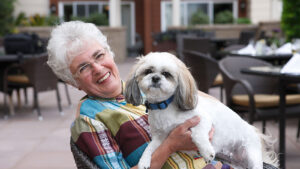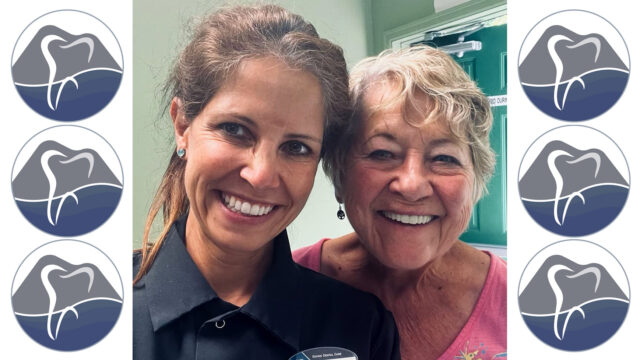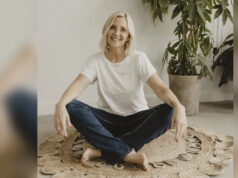Welcome, everyone, back to Answers for Alders Radio Network. And I am here with Sarah Luetke, who’s the founder and CEO of Sound Dental Care. And they are an organization that are in Washington State in Greater Puget Sound, but they’re connected to a national organization that does similar types of programs and teledentistry and different things like that. And we’re really talking about the breakthroughs in geriatric dental care and what goes on with seniors and if you have a senior loved one that’s in a senior living community or you know, goes to a community center or any thing like that, there are services available for preventative dental care as well as sometimes to help with maybe some gums, you know issues and things like that that. Hygienists can help without having to pay exorbitant costs. And so, this is here for our listeners today, and Sarah Luetke, welcome back to Answers for Elders. We’re so glad you’re here on our second segment today.
– Thank you, Suzanne.
– So Sarah, we talked a little bit about the industry. It’s very interesting how, you know, the dental industry as a whole, in my perspective, is kind of not done anything to help seniors. And I it’s kind of strange to me because I think I think there’s just been this you know, old practice of well, when when the seniors teeth rot out, then we give them dentures, right, and it’s just this this process of you know, sometimes I know my mom used to feel like she was like herded through like a like cattle, you know, because she had dentures and they you know, pulled all of her teeth and they told her what to do, and it was just kind of a mess. And she ended up in her later years because she had dementia, she wouldn’t even put her dentiers in, you know, and that was kind of her, you know, her practice, and then it was like downhill from that. And I think there’s a lot of younger seniors that don’t want to be in that position. They want to make sure that they keep their teeth um healthy. But then there’s that fear of going to the dentist and then all of a sudden you get laid out with this plan that’s going to cost thousands and thousands of dollars, and if you’re on a fixed income, you don’t necessarily have those options available. And so Sarah, thank you for being here, and we’re very excited to learn a little bit about what goes on in the dental industry and what’s new.
– Yes, I’m excited to share this this with you because COVID changed a lot of things for a lot of people, and tele-dentistry and mobile dentistry was just kind of being spoken about prior to the pandemic, and the pandemic really sped things up with mobile dentistry. And if you start to Google mobile dentistry, there are many many people – providers, whether it be dentists, hygienists, dental therapists, denturists – all different people in the dental field as well as the medical field – starting to be mobile and everything in our country, and not just our country, throughout the world, we want Amazon to deliver to us. We want things to be your access and so thinking outside of the box of traditional dentistry is really opening up doors and, for myself as a hygienist, there are limitations put on us as hygienists as far as what we can do without the supervision of a dentist, and tele-dentistry is changing that as well, because we can have an offsite dentist supervise us or diagnose something and give us permission to treat a patient in a different way. it’s called asynchronous and synchronous. One of them is a live video chat, just like this with you’re the dentist, I’m the hygienist and the patient’s right here, and or there’s the asynchronous where it’s recorded and the dentist goes to it at their own time, and so there’s those options now. The other thing that people are starting to think about is running – me being a previous employee at a dental practice and now owning my own practice, I operate under a small segment of a Washington law that allows hygienists to operate independently and in certain settings only, so I can only see patients 65 and older at nursing homes and senior centers, or I can see disabled patients, or you can see under-privileged, privileged- school aged children and Headstart programs. So there’s a few sections there that were allowed to see.
– So you are basically kind of that that person that can kind of do things for people that may necessarily not be able to make it into a dental office.
– Yes, yes, And that is exactly why I created Sound Dental Care because seniors. You started out by saying seniors tend to be more on a fixed income, and that’s ALL seniors. That’s not just our nurse. That’s all seniors, that’s anyone that is no longer has an active paycheck coming in, and so we have to think about people’s budgets in a different way. And often times people no longer have dental insurance once they are no longer with their employer dental insurance. Patients have this mindset that dental insurance pays for their whole dental appointments. It never has and it never will. It tends to pay portions of it, and then the patients are responsible for portions of it. But I have a whole new understanding of the cost of running a practice now that I run a practice and I’m not just an employee, and so I think what dentistry has found as well as medicine is being mobile. You don’t have the overhead as much as you do with a brick and mortar and, so even though I’m a hygienist doing more of an alternative setting, I think over time you will see more and more providers, dentists and just everyone being able to go and serve all different seniors. That’s their understanding.
– So Sarah, do you have like a van, how do you operate? I mean, do you come in with a van and a dental chair or how do you operate?
– That’s a great question. For our nursing homes, once again, COVID the pandemic changed everything because we started our practice in 2016, and we did bring a dental chair into every facility. we go into, and we have, you know, a patient chair, dental chair, and an operator chair, and we have the whole ultrasonic and the suction and everything like you would have at the office. But due to the pandemic, a lot of these facilities could not buy state mandates let patients out of their room. So we’ve really had to roll and just every day was different, and it’s still different because they’re still dealing with closures and nursing homes because of the pandemic. But for my hygiene practice, I per for to take everything in and all of our providers take everything into the building. Now I’m also a denturist, so I have a mobile denture van, so it’s set up that I have everything out in the van. The patient is still in the building, but if I need to go do something with their dentures, I can go out to my mobile denture van and that’s awesome like a lab. There are other providers that do have patients come into their van or their motor home for services, but we prefer with our setting because we work with patients that need assistance in transferring and everything, and they’re higher-risk patients that we are in the building. And that makes sense too because staff is there too, which which also you know, you never know, especially if if a senior has dementia or something like that, they can also flip out, have a panic attack anything like that. There’s a lot of memories of the dentists and you just don’t necessarily know what you’re dealing with, so that is a good thing. So you bring an actual dental care dental chair in with you, Yes, I prefer there’s a company just the other side of the water over in Seattle. It’s called Aseptico and they are one of the leading companies and mobile dentistry, and they make all of the field equipment for the military.
– So incredible.
-And so their chairs can hold a 300 pound sailor. And I’ve gone over and toured their plant and I’m a huge advocate for Aceptico. I’m not sponsored by them at all, but I really believe in their equipment. They have the rolling suitcases that I can unpack and it’s just like everything you would have at a dental office.
– That’s amazing. That is amazing. So, obviously, when somebody goes to a dentist, like for example, they’re gonna go in and they’re gonna get this plan to get their teeth clean. That’s kind of the standard thing. They take X rays or whatever. If they can’t afford it, you provide a different option, do you not do?
– Yes.
– So we have about five minutes left. I know we’re going to go right into it in our next segment. But could you the point I think that I really want to bring out more so here is is that most of what you do is is preventative type treatment, but there can be some things you can do to help on the other side, to help me think better. And and could you explain kind of the difference for us?
– Yes, so this is my soapbox… and it’s a product called silver diamine fluoride, and many many people have not heard of it. Silver diamine fluoride has been around for over a hundred years. However, in America we quit using it. We had it here in our country, and we quit using that when local anesthetic became available, and when drilling and filling became an option, and when patients started thinking cosmetics, and so it just kind of went away. In Japan and in South America, silver diamine is used a lot. And so what it is is that as a prescription, it has to be applied by a dental provider and it is a liquid antimicrobial, it contains silver and fluoride, and the silver ions, so if you put it on a cavity or a tooth that’s broken off at the gumline or I’m in my 40s, I paint all of my crown margins with it because I do not want decay around my crowns, I’m going to it as the preventative before i even have decay. But if you do have decay, as long as you have access to the lesion – the cavity – it will arrest it. The silver gets within the tooth and it terms that area of the tooth black. So it’s not aesthetically pleasing, but it won’t turn your home off black. I painted it on my front tooth to show people. It doesn’t turn it black, but it will turn a cavity black, and it’s hard. It’s now arrested and mineralized. And um, this is an option. It can be a solution. That’s not to say sometimes you won’t still have an abscess form or need to filling down the road. Um, that can still happen, but with traditional dentistry that can still happen as well.
– Well. We’re going to talk about this in our next segment, and so we’re gonna talk about all kinds of things and prevention and Sarah and I will be right back right after this.
















